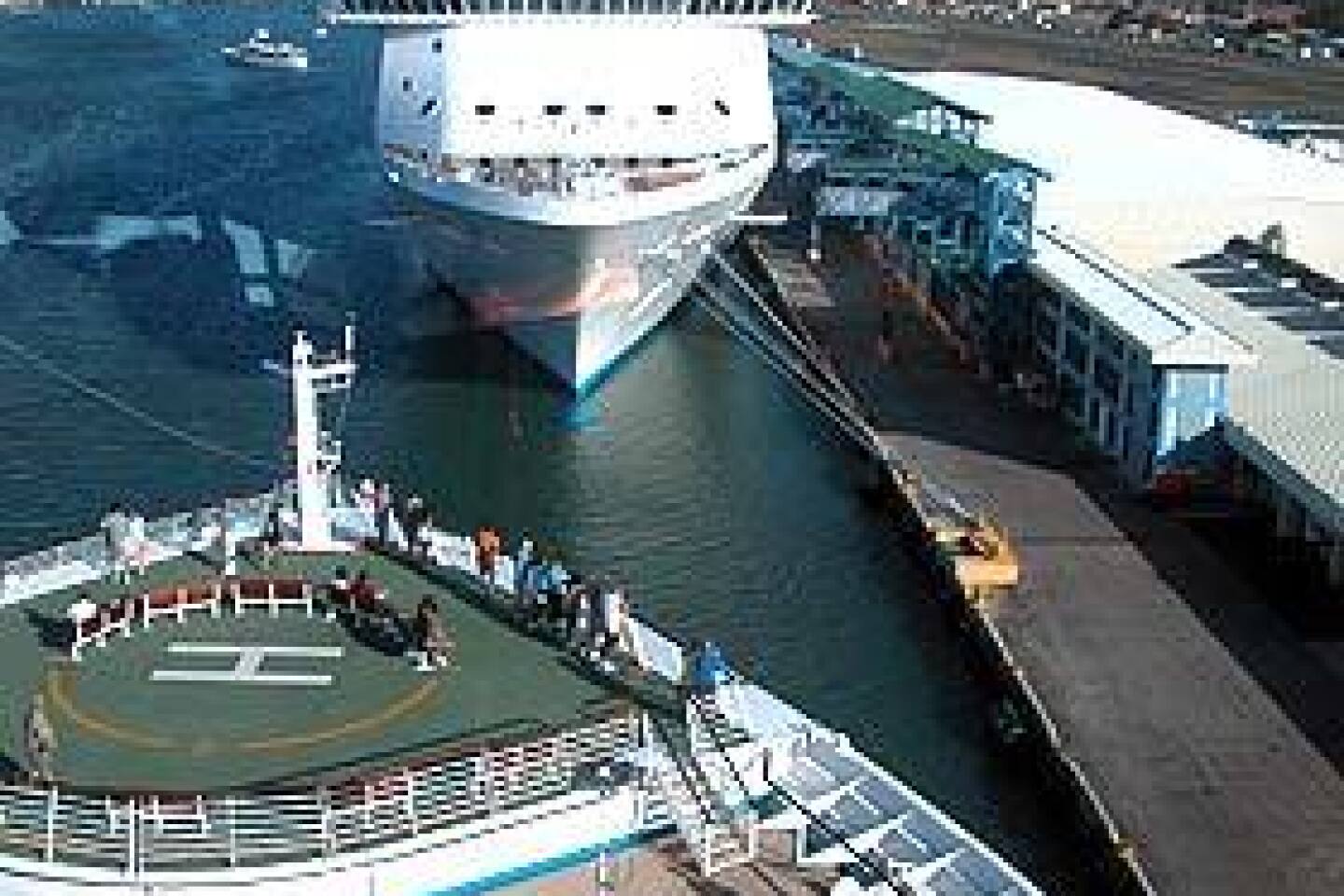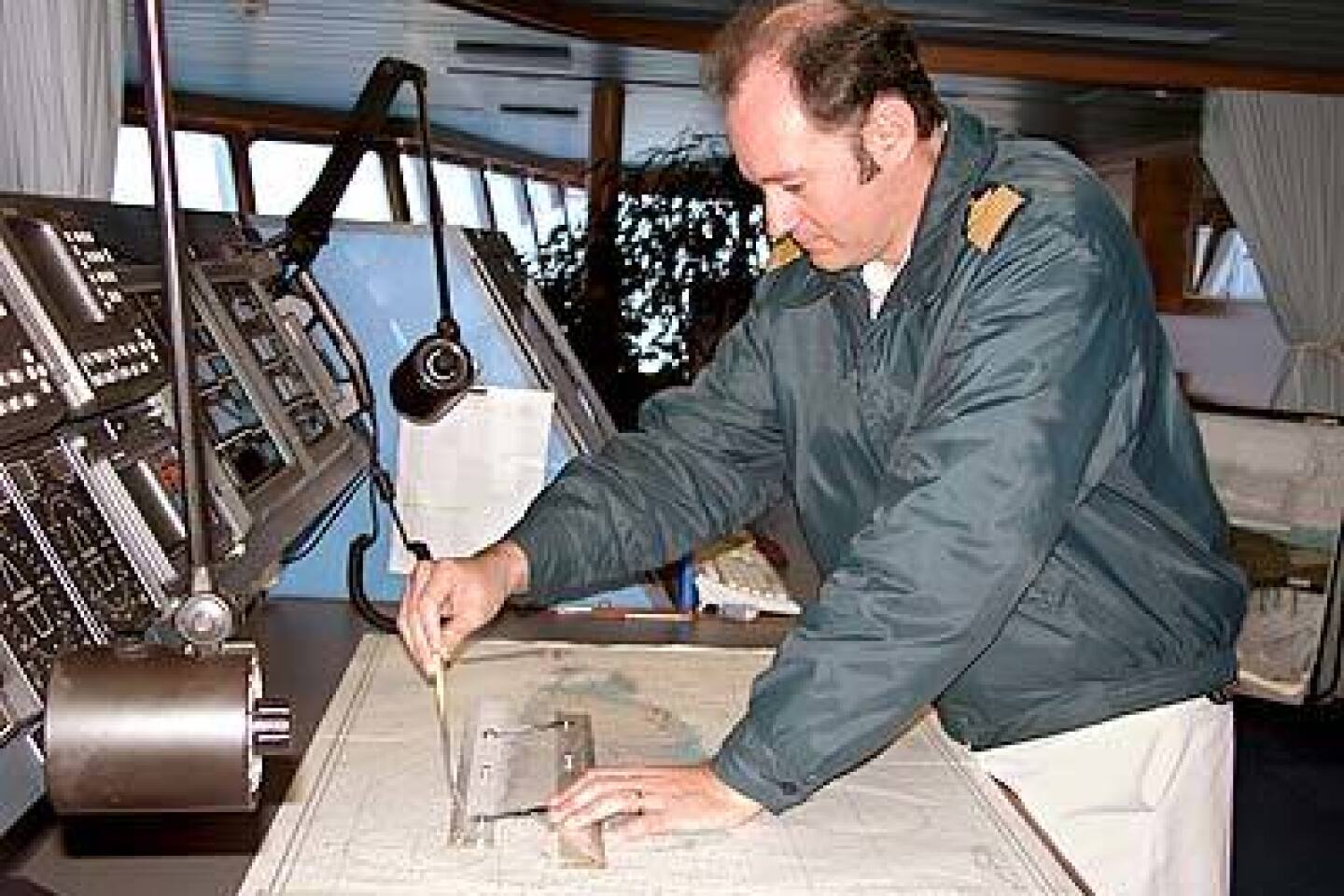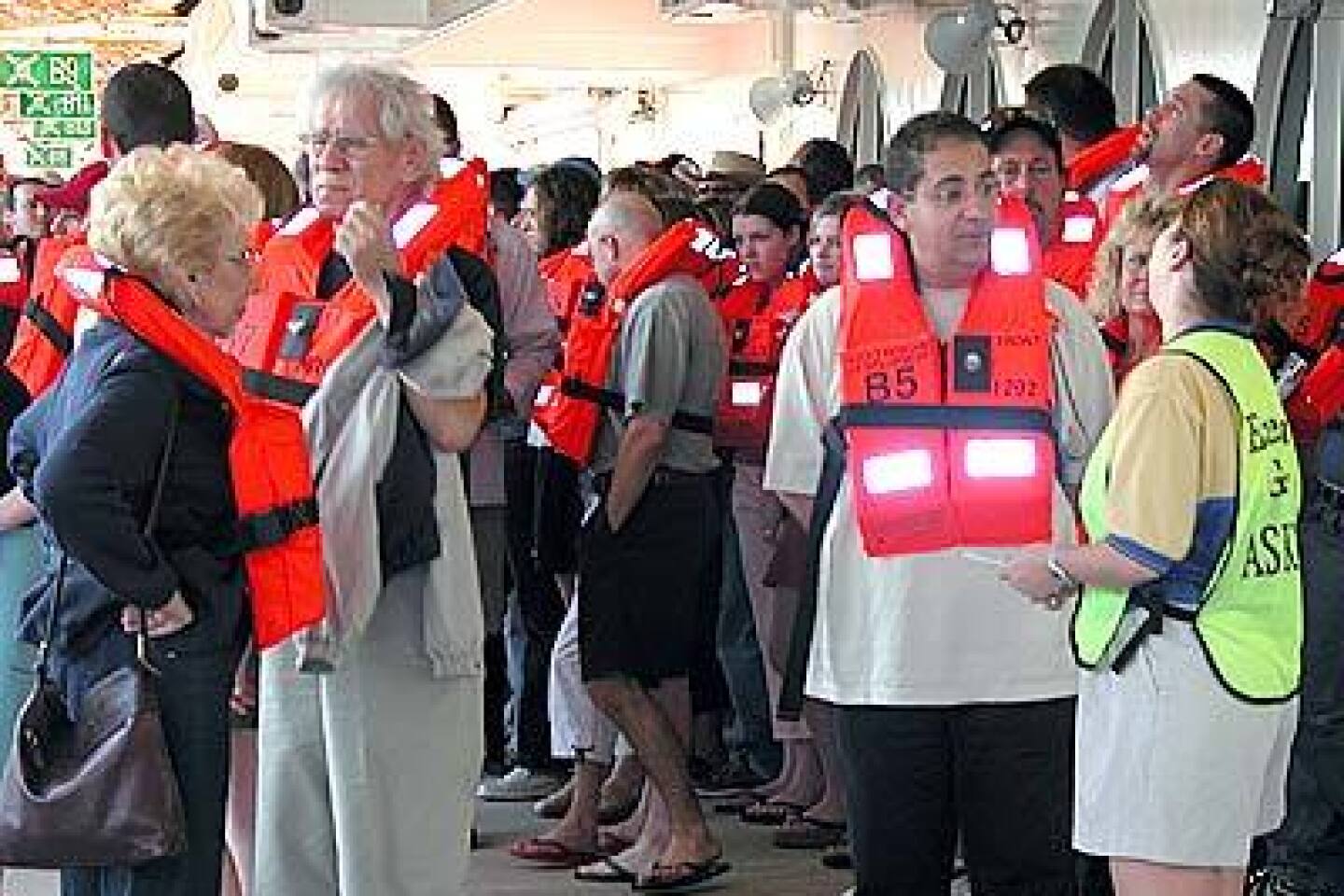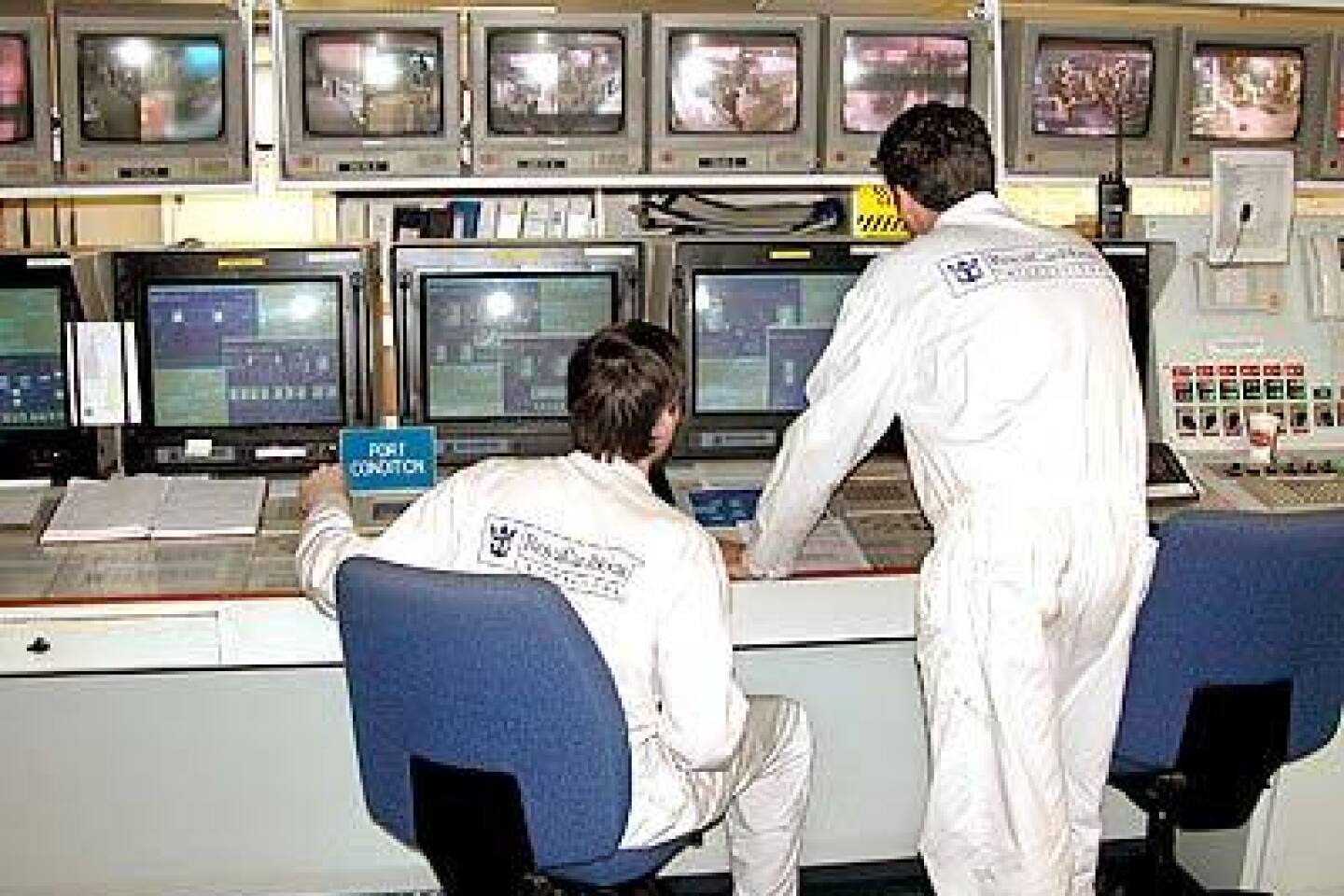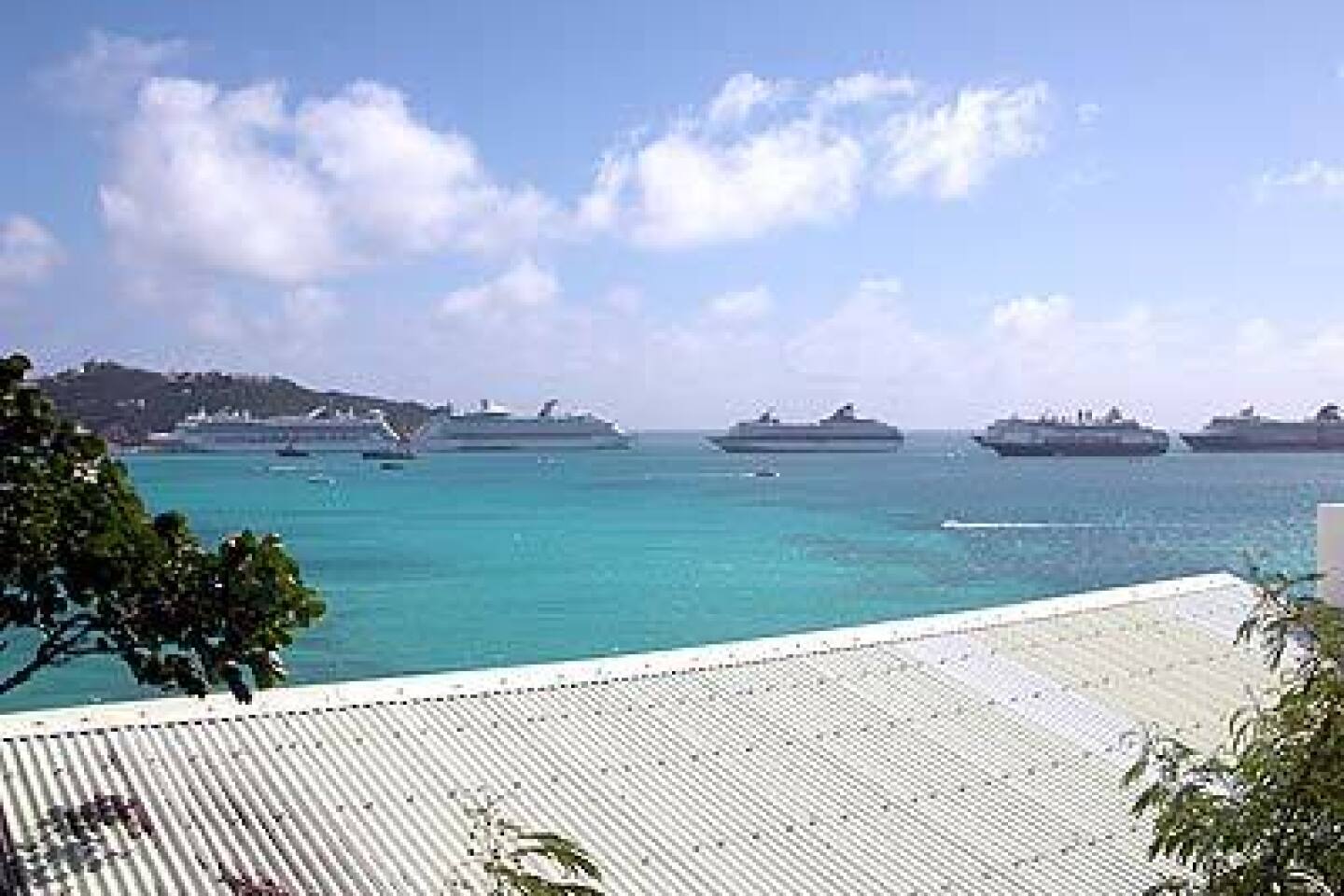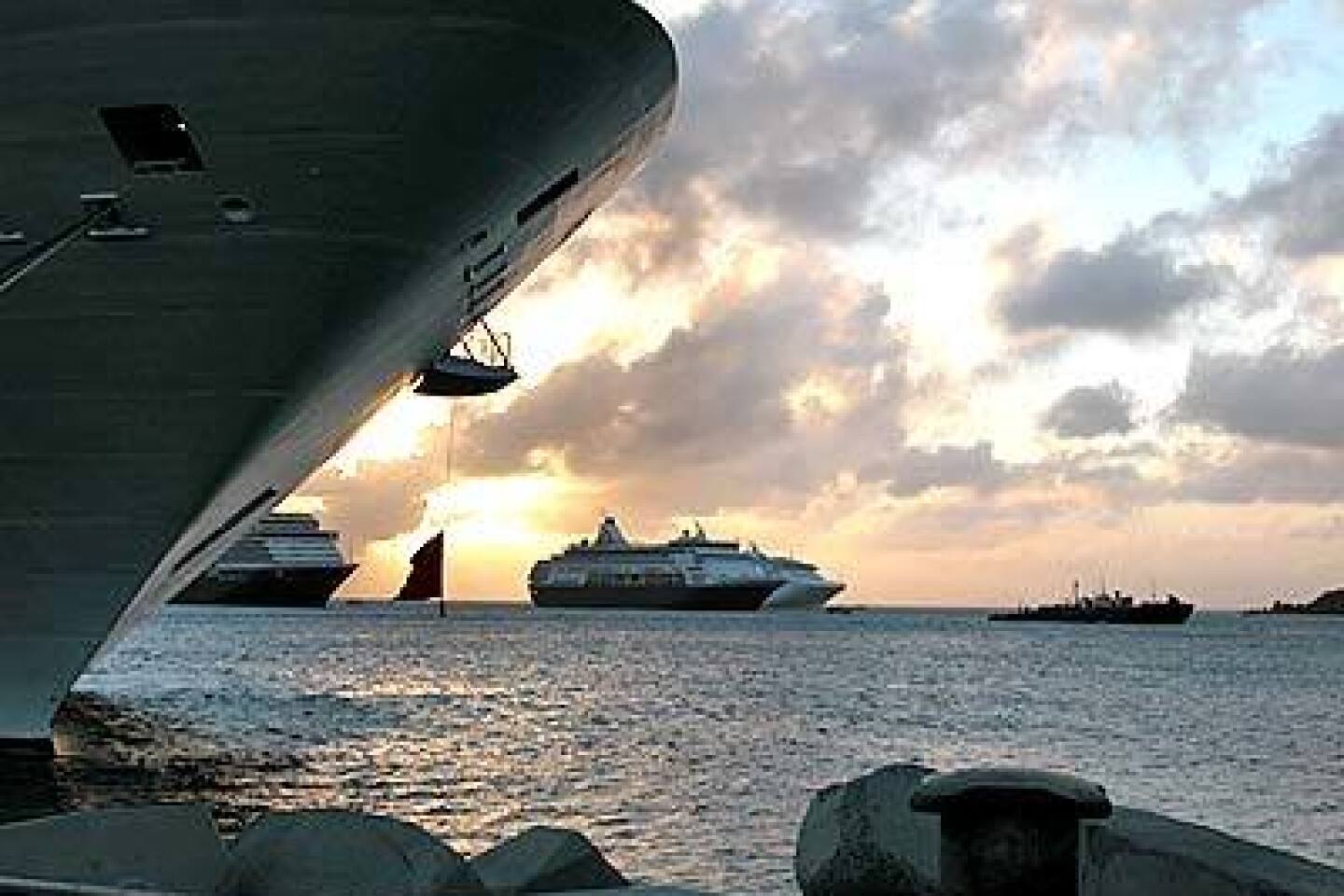The young captain and the sea
- Share via
Attached to the arm of the captain’s chair was a black joystick. With it the skipper can change the direction of the ship. I glanced out at the sea. It was clear to the horizon. Lazy clouds floated high above the water. Whitecaps skipped across an unending blue panorama. It was a beautiful day on the Caribbean.
I was 10 stories above the sea on the massive bridge of a $550-million cruise ship, one of the world’s largest. On board were nearly 5,000 passengers and crew. I settled into the black leather chair and grasped the joystick with my right hand.
I was now in control of the ship. Curving in a semicircle in front of me was a huge starship-like control panel. Red and green lights winked at me, monitors blinked with radar blips, nautical charts came to life on video screens. Hundreds of switches and buttons beckoned.
Suddenly, a wave of doubt washed over me. Maybe I should try this later, I thought — after I know which buttons to push in case the ship tips over. I released the joystick and hopped out of the chair.
OK, so I was never really in control. But I was sort of a pseudo captain last month on a weeklong Royal Caribbean International cruise. The real master of the ship, Capt. Carlos Pedercini, let me tag along for a behind-the-scenes look at a very big job on a very big ship. His vessel, the Explorer of the Seas, is 1,020 feet long — second only to Cunard’s Queen Mary 2 in size. Placed on its end, it would be nearly as tall as the Empire State Building.
It’s a bit bigger than the boat I usually skipper, which is 18 feet long, has a canvas top, is powered by automobile batteries and never goes outside the bathtub-calm canals of Long Beach. When I told Pedercini — crew and passengers call him Capt. Carlos — about my boating skills, he nodded politely. “That’s nice,” he said.
Cruise ship captains are exceedingly polite. It’s one of their many talents. They’re also part father figure, part social guru, part navigator and part boss. The downside of the job is that they could end up going down with the ship if someone were to make a mistake.
But with such awesome responsibility come some perks. There’s the celebrity factor, for one. Captains are popular guys.
“Guests wish to see and meet the captain,” said Pedercini, a tall charmer from Argentina. “They want their pictures taken with me. They want to talk with me. They want me to be where they are.”
That was how I first spotted him. Pedercini was the center of attention at a picture-taking session on the Explorer’s Royal Promenade deck — a flashy shipboard mall. Crowding into line were a half-dozen couples who wanted to have their photos taken with him. The dress code that night was formal, and the women were in silver-sequined tops, ill-fitting prom dresses, beaded trouser suits and faded bridesmaid’s gowns. In their dark suits, most of the men looked uniform in comparison.
Pedercini left the line eventually to bound onto a stage above the mall after a trumpet fanfare and a few chords from “Don’t Cry for Me, Argentina.” He cracked some jokes — “I am the master of the Explorer of the Seas, and I have my wife’s permission to say so” — and introduced his top officers, each honored with a few chords from their national songs. The audience gave the captain its rapt attention, laughing at his jokes and loudly applauding his comments. There was no doubt about it: He was the evening’s superstar.
Pedercini admitted later that he enjoys the role, “but I’m not a real celebrity,” he said. “When I get off the ship, no one knows who I am. Real celebrities can never get away from it.”
He and other cruise ship captains have a TV series to thank for the luster. In the 1970s and ‘80s, Gavin MacLeod glamorized the job in his role as Capt. Merrill Stubing, longtime master of “The Love Boat.” Sailing with him during the series were more than 1,000 real-life celebrities, including such old-line luminaries as Ginger Rogers and such young actors as Tom Hanks.
“People still come onboard looking for the ‘Love Boat’ captain,” a gift shop clerk said, “but I think Capt. Carlos is cuter.”
Pedercini laughed when I asked about the show. He had watched it as a boy in Mar del Plata, Argentina, his hometown. “It was fun to watch, but [it] isn’t anything like real life. They had so much time. It makes people think we’re on vacation all the time.”
On the contrary, the ship’s captain is never off duty. The Explorer sails every Sunday from the Port of Miami, returning the following Sunday. The captain unloads one group of 3,000-plus passengers before noon and takes on another group after noon, with no time off.
“It’s like every day is a Monday,” he said, a bit wearily. But he was smiling. I got the impression he doesn’t mind the routine too much. It helps that his wife and 18-month-old son are onboard with him part of the time. And there’s always vacation to look forward to. He rotates with another captain, working 14 weeks, then receiving 14 weeks off. It’s enough time to go home to Buenos Aires. The company pays for round-trip transportation, as it does for most other ship employees during their breaks.
Last fall, he drew the short end of the stick with his schedule, however. His 14 weeks at the helm coincided with the four devastating hurricanes that swirled through the Caribbean. He was at sea, responsible for his ship and thousands of passengers and crew.
What did he do?
“I ran away,” he said without hesitation, describing anxious dashes across the West Indies archipelago to avoid the storms’ paths. “I will not take any chances. Some guests don’t understand, especially those who come from the middle of the country and aren’t used to the ocean. They say, ‘I was supposed to go to these ports.’ But when there are storms like those “ He left the sentence hanging. “Safety is my primary concern.”
Pedercini is 40, the youngest captain in the fleet and “the only crazy sailor in my family.” His Italian grandmother was so unhappy about his long absences at sea that she made him kiss her three times whenever he left on a cruise.
“She would always say it was because she was getting older and might not be there when I returned.” Her comment had the desired effect: He felt terrible. Until one day his grandfather pulled him aside. “He said to tell her, ‘Life at sea is very dangerous and I might not return.’ ” He argued with his grandfather but took his advice. When he spoke the words, his grandmother was livid. “Never say that to me again,” she said.
“My grandfather died a month later,” Capt. Carlos said. “He was right. My grandmother never said it to me again.”
*
Alarms were sounding throughout the ship. A fire had started in an engine room and was quickly discovered, but even more quickly it leapfrogged out of control. I was on the bridge as emergency measures were attempted. I walked to the broad windows and looked down at the ship. Five decks below I could see hundreds of crew members gathered in their orange life jackets, awaiting the order to abandon the ship. The situation seemed desperate. I gave the order. Within minutes, yellow lifeboats were being lowered into Long Bay off the coast of St. Thomas, U.S. Virgin Islands.
*
OK, so it was a drill. No one cared that I was role-playing at the same time they were. The crew acts out emergency scenarios weekly; this one took place after we’d docked in St. Thomas, which allows lifeboat drills to be held in its bay. The scene was sobering. Especially when Pedercini reminded me that if I were the real captain, I’d have to remain on the bridge until everyone else was off the ship. I imagined myself sadly waving goodbye as the others floated away from the inferno in canary-yellow lifeboats.
Fortunately, I didn’t have to test that. Our cruise was mellow: Good weather, fair winds, nice ports — St. Maarten; San Juan, Puerto Rico; and Nassau, Bahamas — joined St. Thomas on our itinerary. And there was plenty to do onboard: ice skating, rock climbing, miniature golf.
The most dangerous thing the captain faced may have been trying to avoid bumping into other cruise ships. During the prime winter cruise season, they are everywhere in the Caribbean. When we docked at Philipsburg, St. Maarten, nine large cruise ships were in the harbor with us, disgorging 30,000 people onto the 37-square-mile island.
“I don’t go ashore during the winter,” Capt. Carlos said. “Too many ships, too many people. In the restaurants, in the stores, everywhere.” He said he planned to visit San Juan when we docked there, “but only because I have to pay a bill.”
Down to business
While passengers were elbowing one another out of the way on land, the captain and crew took care of business on the ship. Some tasks were boring; some were corporate. A “results-oriented management meeting” on Wednesday morning was both. Even glamour jobs like cruise ship captain have their share of tedious tasks.When he wasn’t needed elsewhere, Pedercini roamed the passageways, checking frayed carpeting in the photo shop, the temperature of the refrigeration unit in the milk storeroom, the condition of the lines around the bollards on the dock. And he was on the bridge whenever the ship entered or left a port.
“As the level of risk increases, we increase staffing on the bridge,” he said as the Explorer sailed toward San Juan. Only two officers and an assistant are needed on a calm day at sea when conditions are considered “green.” Six people are required on the bridge when conditions turn “red,” as they do when the ship enters a port.
Thirty minutes before the ship’s anticipated docking time, he briefed the officers and listened to a weather report. “Stay alert,” he cautioned them. “San Juan is full of surprises. We’re in condition red.”
The entrance was smooth. Unfortunately, exits often aren’t. And often it’s the passengers’ fault. Many of them ignore the dictum to be onboard 30 minutes before departure. In Nassau, 200 people hadn’t returned by the deadline.
We watched from the bridge as latecomers returned: A few were running to make it in time but most strolled leisurely, shopping bags in hand. The officers did a slow burn.
“Ten years ago, people weren’t like this,” Pedercini said. “They returned on time. I don’t understand. People don’t come to an airport late and expect the plane to be waiting for them.”
“We burn 10 tons of fuel an hour,” said Staff Capt. Frank Martinsen. “We can’t wait.”
And often they don’t. “I don’t choose to leave anyone behind. They choose not to sail with us,” Pedercini said. Fortunately, everyone made it that day, and bridge staff members relaxed and prepared for departure.
“Do you want to push the button?” Pedercini asked me. “Hold it for 10 seconds.” I flew across the room, holding my breath. It was my big moment. I stood up straight and reached for it. I counted 10 seconds as a deep, resonant blast echoed across the water.
“Perfect,” the captain said, nodding at me. I danced around the room as the officers laughed at my excitement.
I may not have steered the ship, but I did honk the horn. And that’s more than most can say.
Anchors aweigh
THE CRUISE:
Royal Caribbean Cruises, (800) 327-6700, https://www.royalcaribbean.com , based in Miami, has two cruise lines: Royal Caribbean International, with 19 ships, and Celebrity Cruises, with 10 ships. It is the second-largest cruise company in the world, behind Carnival Corp., and carries nearly 3 million people a year to more than 150 destinations.
Explorer of the Seas operates weekly cruises year-round in the Caribbean; its itinerary is seven nights in the eastern Caribbean (Miami; San Juan, Puerto Rico; St. Maarten; St. Thomas; Nassau, Bahamas) followed by seven nights in the western Caribbean (Miami; Belize City, Belize; Costa Maya, Mexico; Cozumel, Mexico; and Grand Cayman). Prices begin at $599 per person, double occupancy.
— Rosemary McClure
More to Read
Sign up for The Wild
We’ll help you find the best places to hike, bike and run, as well as the perfect silent spots for meditation and yoga.
You may occasionally receive promotional content from the Los Angeles Times.


